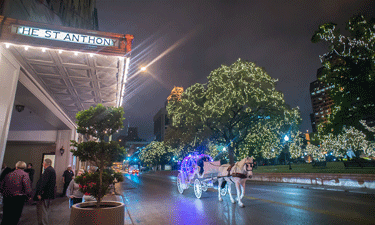 Walk through any big city in the U.S. and you will undoubtedly come across a park in need of some tender loving care. Often, as a city grows, priorities and investments shift. Green space and urban parks can suffer as a result. What were once beautiful gathering spots for the community become places to avoid.
Walk through any big city in the U.S. and you will undoubtedly come across a park in need of some tender loving care. Often, as a city grows, priorities and investments shift. Green space and urban parks can suffer as a result. What were once beautiful gathering spots for the community become places to avoid.
Travis Park in San Antonio, Texas, was one such place in need of renewed focus to make it great again.
What makes Travis Park special is not its size or features, but its history. This fact was not lost on Pat DiGiovanni, CEO of Centro San Antonio, a company dedicated to fostering a vibrant, thriving urban core in Texas’ second-largest city.
Travis Park, located in the heart of downtown San Antonio, was once part of the Alamo mission, the site of the famous Battle of the Alamo that served as a catalyst for Texas’ fight for independence from Mexico. Now separated from the mission by streets and buildings, the park had lost its once-charming appeal from simple neglect.
The city recognized an opportunity to revitalize the park and received investments from the private sector, led by Southwest Airlines and the San Antonio Parks Foundation.
After a $500,000 renovation that included replacing sidewalks and furniture, as well as adding a new community bikeshare point, the park was ready for a new future. DiGiovanni saw an opportunity to provide new life for the park. How do you reverse decades of opinions? “One day at a time,” DiGiovanni says.
After the facelift, “We wanted to show the community that Travis Park was once again a place for families,” DiGiovanni says. To get families to the park, DiGiovanni and his team hosted a series of themed events at Travis, starting with the Fall Festival, a free event with a pumpkin patch, scarecrow contest and face painting.
The occasion was a huge success and sparked thoughts of “what next?” DiGiovanni drew upon his previous experiences in cities such as Kalamazoo, Michigan, and Surfside Beach, South Carolina. With the holidays approaching, DiGiovanni provided 250,000 reasons to come to Travis Park to celebrate. Installing 250,000 holiday lights transformed the space into a vibrant explosion of cheer and brought scores of people to the newly renovated park.
The culmination of the events was “Let It Snow: A Holiday Celebration.” San Antonio hadn’t seen major snowfall since a 1985 storm laid down a foot-thick white blanket. “Obviously, we don’t get too much snow down here,” says DiGiovanni. By bringing in 25 tons of man-made snow, Centro gave thousands of local kids their first taste of a proper sled ride down a snowy hill and making a snow angel. There were even a few snowball fights.
While a tremendous amount of time and effort went into the event, “it was all worth it to see the kids smile and the parents laughing and taking pictures,” DiGiovanni says proudly.
While each event was fun and brought many people to the park who may have not otherwise visited, DiGiovanni insists that there was a higher purpose. “We wanted to show citizens and visitors that a successful city has a vibrant downtown, and a vibrant downtown has areas for work and play,” he explains.
DiGiovanni has deep roots in serving the public. After earning his bachelor’s from Northeastern University and master’s at the University of Pittsburgh, he began working for the public sector. He worked his way up from a small-city director of finance to city manager in Kalamazoo. “I have always loved my work for cities, through the challenges as well as the good times,” he recalls.
While not all of DiGiovanni’s work over the years has focused on parks, he cherishes times when his work involves parks and green spaces because he can combine two of his favorite activities — helping the public and being outdoors. While working in Surfside Beach, he led the effort to build the first children’s park in the state that was accessible and usable for youngsters with disabilities.
What Travis Park lacks in size at just 2.6 acres, it more than makes up for in character. “The history of Travis Park is one of the many reasons we wanted to show it off,” DiGiovanni expounds, “and successful downtowns have parks that bring people together from all walks of life.”
It’s been an astounding transformation. A year ago, Travis Park was uninviting and a bit scary. Now it is a jewel of the city and a symbol of what can happen when the public sector and private sector share a vision and work together to achieve it.
Casey Whittington is a Senior Account Executive with The Whittington Group.

